I can’t tell you how much fun it is to create beauty from kitchen waste. I also really love free plants.
With pineapple (Ananas comosus), you can have both.
From the leafy top of a pineapple — the part you would normally discard or compost — you can grow a beautiful plant that may bloom and produce fruit.
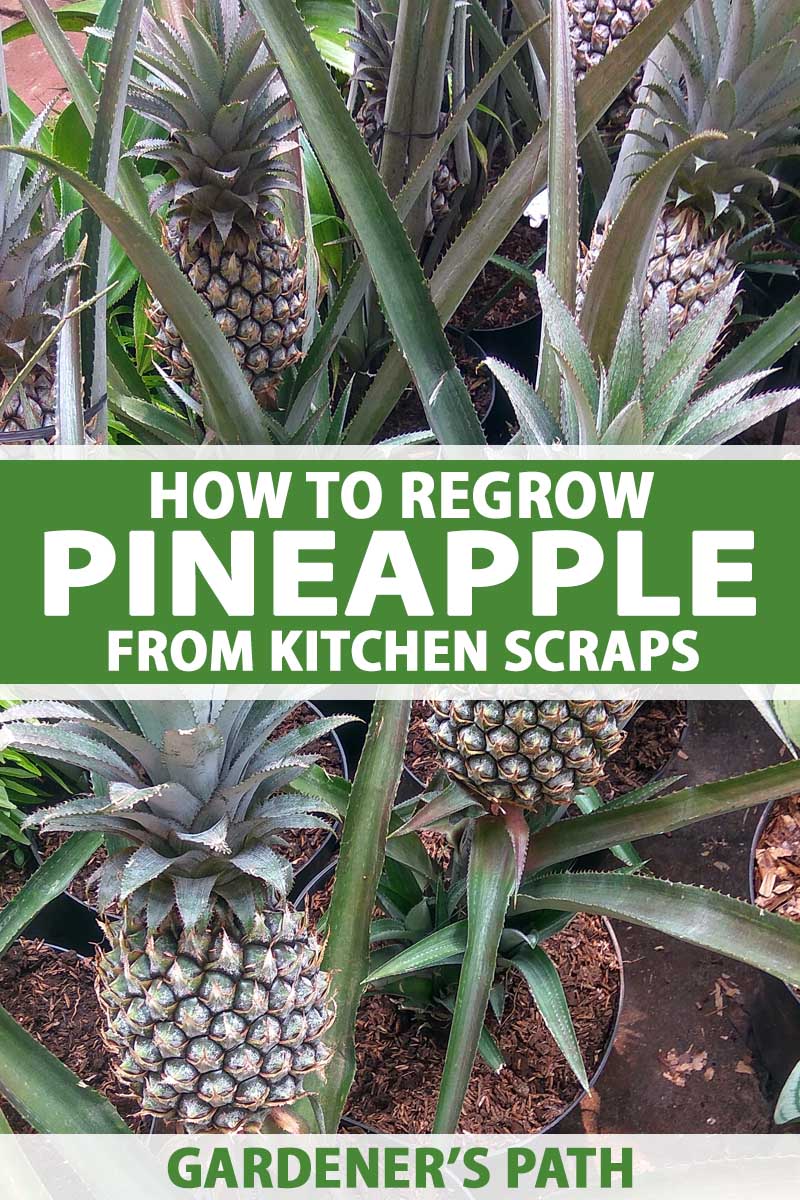
We link to vendors to help you find relevant products. If you buy from one of our links, we may earn a commission.
Let’s get started!
First, We Eat
Select a healthy pineapple at the grocery store that has attractive, healthy-looking foliage. Slice the top part off about 1/2 inch below the base of the cluster of leaves.
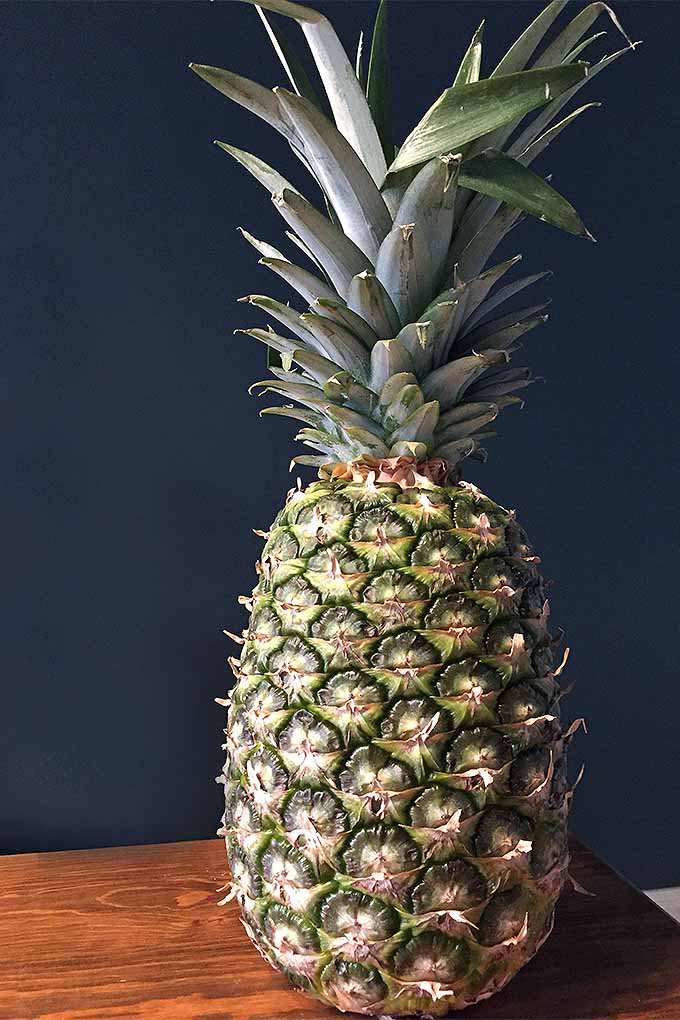
Cut up the rest of the pineapple as you normally would, and chow down as you prepare the top for planting.
Trim away the tough outer “skin” of the pineapple top, and remove a few of the lowest leaves. Place the crown in a sunny spot to dry for three to five days. This allows the moist core tissue to dry and discourages rotting, according to Richard Jauron at the University of Iowa Department of Horticulture Extension and Outreach.
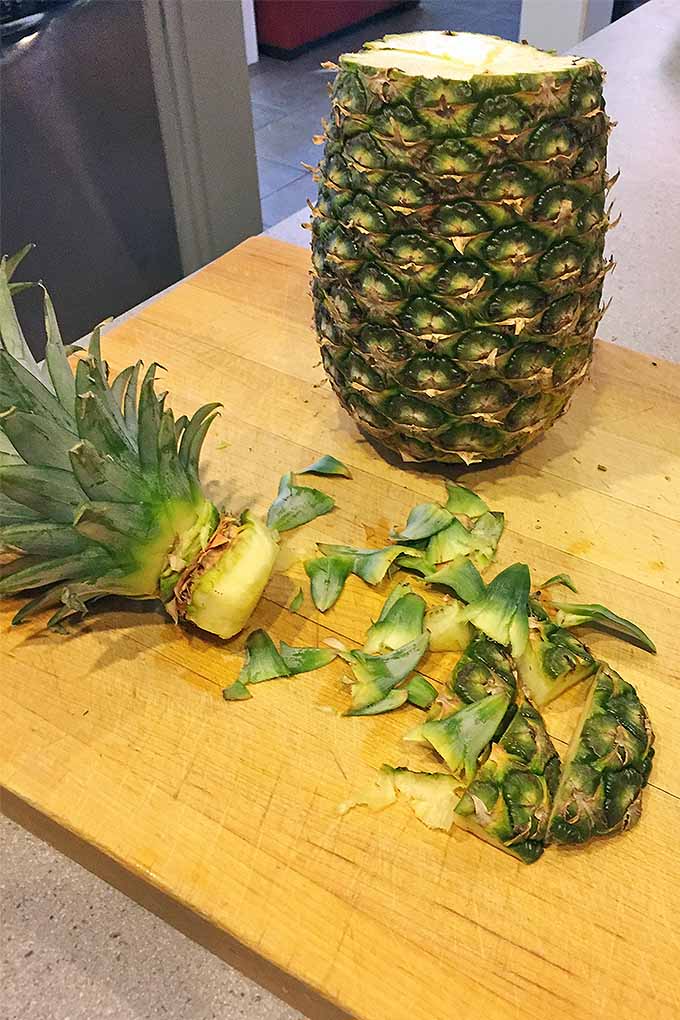
Next, you can then either place the crown into water or soil.
Water Method
To root the crown in water, insert toothpicks around the perimeter of the crown and suspend it in the water as you would an avocado pit. Alternatively, find a glass container the crown will just “sit” in.
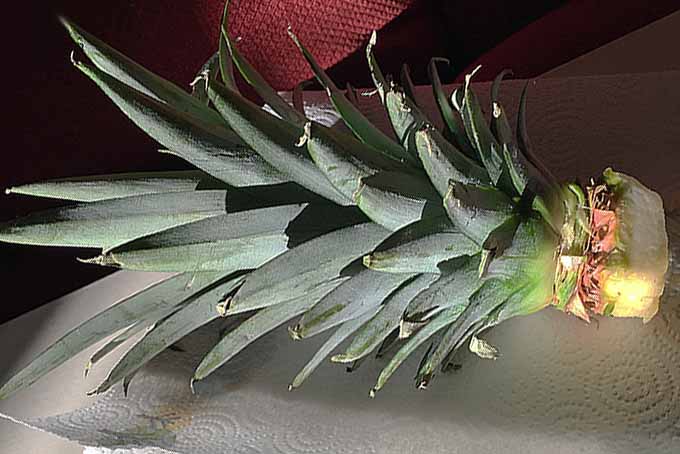
Place the container in a bright spot with indirect light, and change the water once a week.
Roots should form after 2-3 weeks in the water bath. When the roots are 2-3 inches long, you can transfer the crown into a container of light soil mix.
This method is particularly fun for gardening with children in the wintertime, since they can check on the progress of the roots as they grow.
Soil Method
Use a light soil mix made with perlite or vermiculite and sand. Insert the crown in the soil up to the base of the leaves and place in bright, indirect light.
Keep the soil moist, but not wet. Rooting should occur in 6 to 8 weeks.
If you live anywhere other than zones 10 or 11, you’ll want to keep your tropical plant in a container and bring it indoors before the first frost. Super-southerners may be able to plant directly in the landscape.
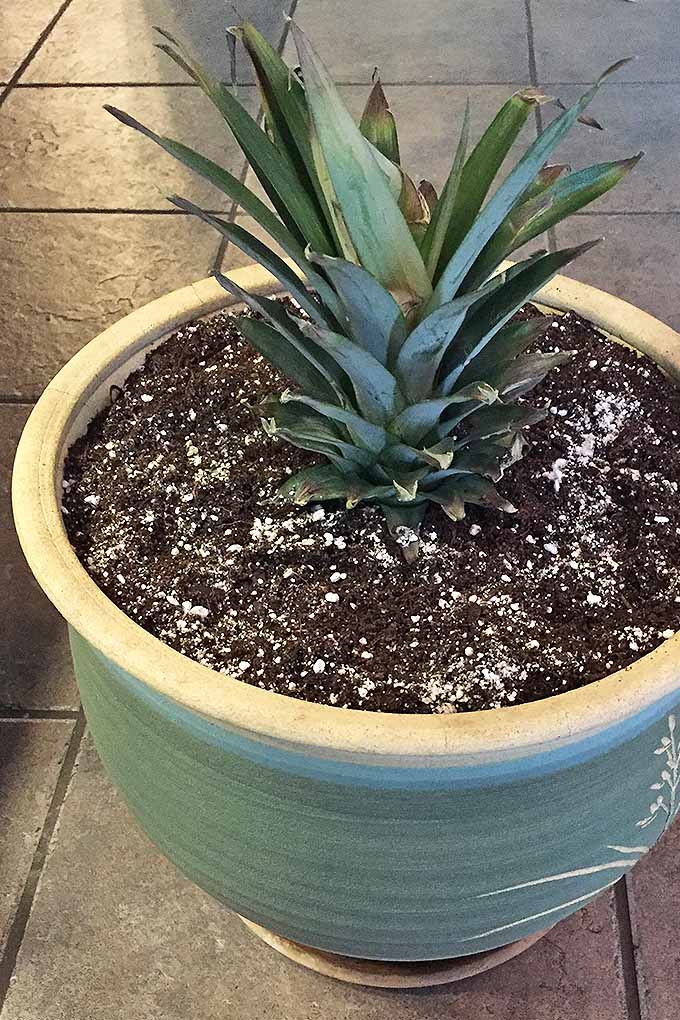
I recommend using a soluble houseplant fertilizer to feed the plant once or twice a month during spring and summer, and just once monthly in fall and winter.
I have to make a confession: I didn’t know any of the above when I started my first pineapple plant from a kitchen scrap. I just cut off the top as I usually do, and stuck it in a pot of who-knows-what soil out in the backyard. And it did just fine on my property in Texas, rooting and growing a beautiful leafset.
To Fruit, or Not to Fruit?
Some folks enjoy these plants as houseplants year ‘round. Others, like me, bring them indoors when it’s chilly but return them to the yard come springtime.
Wherever your plant resides, make sure it gets at least six hours of bright light per day. Allow it to dry out between waterings.

Pineapples are fairly slow-growing, and you might not see blooms for two or three years, if at all. My oldest plant is about three years old and it has yet to bloom. But honestly, I’m just happy with the foliage. If it blooms, that would be a bonus, but I really just like the long, shiny, sword-like leaves.
Some experts say to put your pineapple plant in a plastic bag with an apple, which releases blossom-inducing ethylene gas. This may encourage flowering in two to three months.

If you do get a fruit, saw it off when the outside skin starts changing from brown to yellow. But be careful to beat the greedy squirrels to your bounty!
Mother Nature’s Marvel
I am happy every time I walk by my pineapple plants — I love getting something for nothing. And I love when visitors ask about the unusual plant that’s placed prominently on a walkway in the backyard.
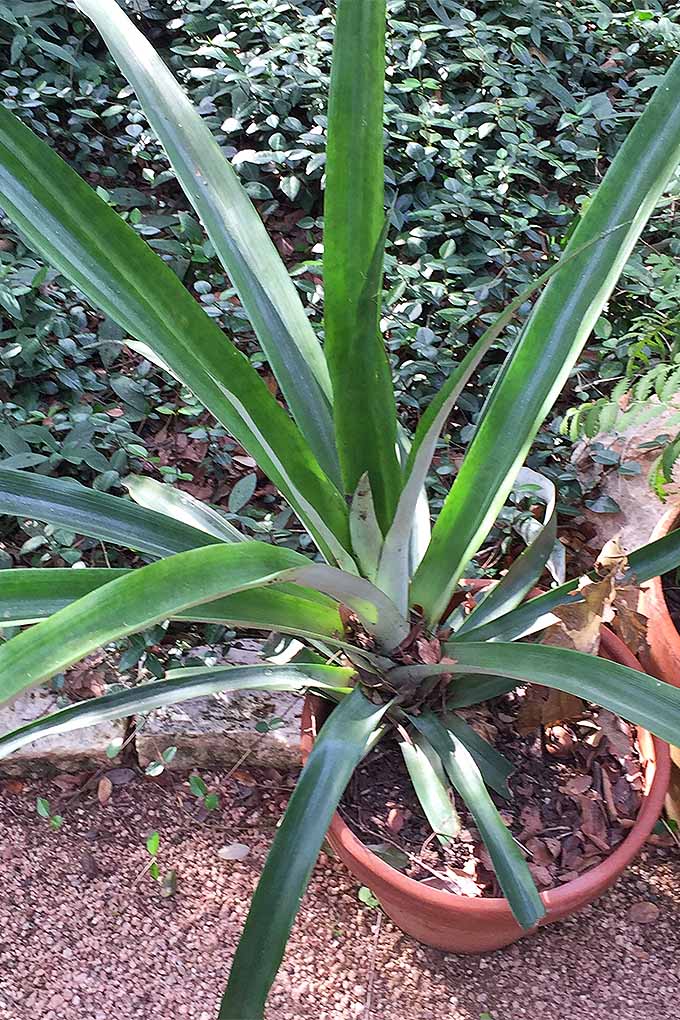
I get to tell them it was from a fruit our family ate a few years ago, and they’re amazed. And then I tell them to just cut the top off, clean it up a little bit and stick it in dirt, and they’re even more amazed.
Have you ever grown a pineapple plant from a kitchen scrap? Did it bear fruit? Tell us about it in the comments section below, and if you’d like to try your hand at growing another tropical plant, consider ginger. or check out our article on growing tropical flavor intensives and herbs at home.
Photos by Gretchen Heber, © Ask the Experts, LLC. ALL RIGHTS RESERVED. See our TOS for more details. Top uncredited photo by Gretchen Heber. Other uncredited photos via Shutterstock.
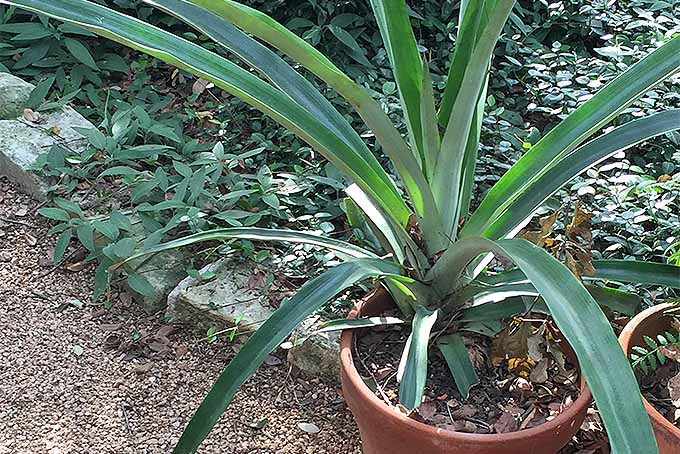
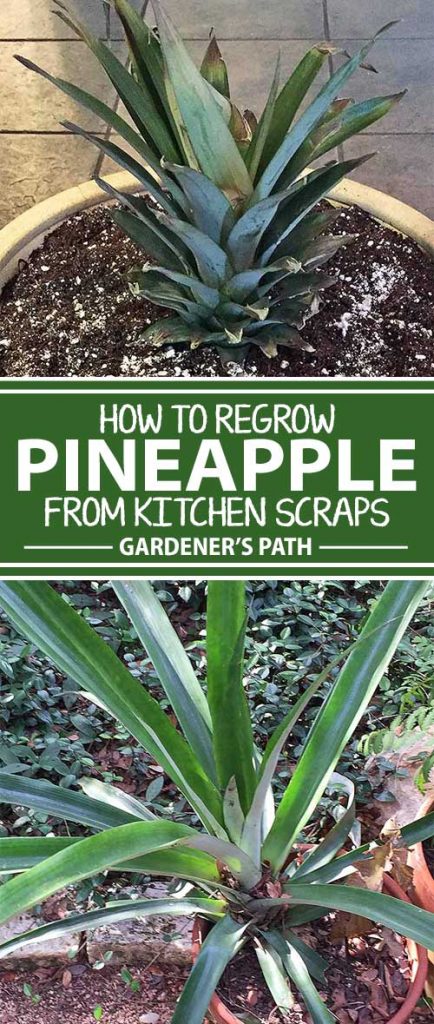
I have a pineapple plant I started about 3 years ago. My sister started one at the same time. She put hers in water and it died. I put mine in the ground and it’s still alive and kicking. I have it in a pot in the house for almost the full 3 years with only the inside lights for lighting. The room is fairly dark. It’s doing great and will need to repot this year. My daughter wants one so I’ll be starting another one for her.
Excellent! If you’re able to provide it with more light, maybe this year you will be able to coax it to bloom. 🙂
the pineapple on my plant looks very small and now it is sprouting more leaves from the top? I have not seen any flowers…. does it have to bloom first before the fruit gets big?
If you already have a fruit, then you must’ve just missed the flowering part. The flowers comes before the fruit. The fruit itself can take several months to fully develop and ripen.
My pineapple plant is about 7 years old
Will it ever fruit
Hi Sarah . . . I bet your plant is beautiful! You may have to give it a little “help” to bloom. See the tip in the article about an apple and a plastic bag.
How exactly do you put it in a a bag with an apple? Do you uproot the plant and tie it shut with an apple? Or do you put the plant with some soil tied in a bag with an apple?
To do this, you would need to bag the entire plant using a large plastic bag, such as a trash bag. For obvious reasons, this would be easier to do with a potted plant. The plant should not be uprooted to encourage blooming.
How long do you need it covered before taking the bag off?
The advice on this varies, and it depends in part on the ambient temperature, and the amount of ethylene gas that the apples release. Most guides that offer this tip recommend keeping the bag of apples tied around your plant for anywhere from 4 days up to 2 weeks, and this should encourage flowering within 2-3 months. You want to expose your plant to ethylene, but you don’t want to keep the bag of apples tied on there so long that the fruit rots entirely, attracting insects and potentially introducing harmful pathogens to your plant. Using this method in the… Read more »
To get a fruit put an over ripe piece of banana on your plant. It forces it to fruit.
I am raising 3 other pineapples, all of which are growing tall with new leaves from the middle. I attached a pic of my newest plant that has two blooms coming out from the side. It’s been a few weeks and nothing else happened. What do I do?
Hi Brandy –
Shoots pop up where they will, and yours look to be in excellent health. Pineapple is a slow grower. You may help plants along by fertilizing with a soluble houseplant fertilizer once or twice a month through the spring and summer, and once a month in fall and winter. Water only when the soil has completely dried out, and keep plants in a location where they can get six hours of sunlight per day.
I grew one from top, into dirt. Now has pineapple on it, almost ripe. Will try it soon. Placed outdoors in summer and inside by the picture window for winter.
Sounds great, JoAnn! How did it taste?
Hi!! My pineapple plant is still a baby and is only a few months old and it’s in a terra-cotta pot. I was just wondering, do I need to fill the pot to the top with soil? The pot size and how much soil are both posted in pictures. Thank you!!
It’s not necessary to fill pots since you want to have enough room to water, but adding a bit more soil would give the roots more room to grow.
I just harvested a pineapple from my first plant. Is that plant now done, or could it produce again in the future? If so, is there a way I’m supposed to trim it?
A second or “ratoon” crop can grow from a sucker that develops, but there isn’t any additional pruning that you need to do. See our guide to growing pineapples for more tips.
I just harvested pineapples from my yard. Very sweet, delicious. What happens to the plant after you pluck it? Will it bear fruits again in same pod?
Plants will often produce a second, “ratoon” crop!
I have a plant that I started about 3years ago it is taking over my room can I cut it back or will that kill it
Help
Pruning can be tricky with this type of plant. But you can trim any yellowing or damaged leaves, as well as lower leaves, at any time without much risk of harm.
I just ate my first pineapple, when the pineapple started growing on top, it fell over and grew sideways, how can I keep my plant upright?
Bamboo stakes or chopsticks can help to keep rooting cuttings upright!